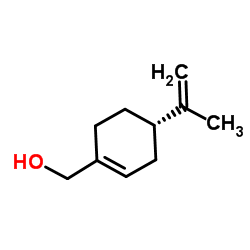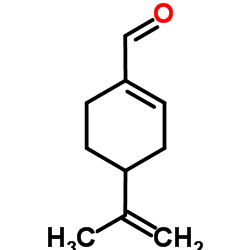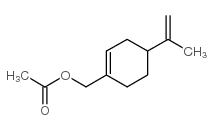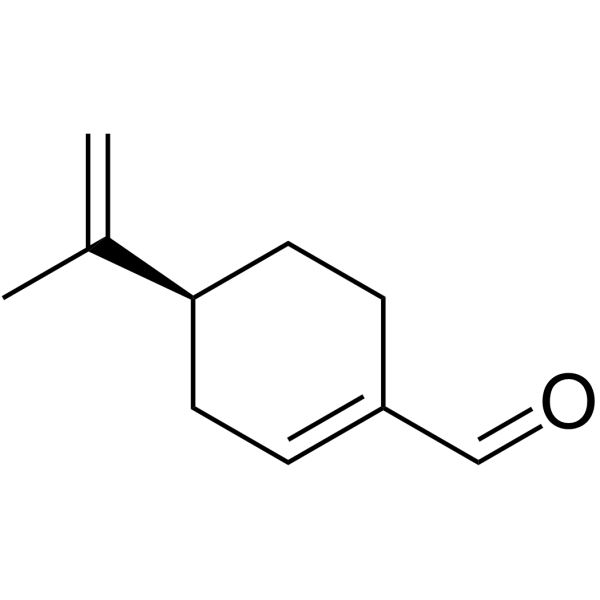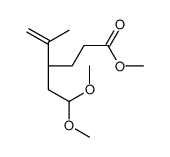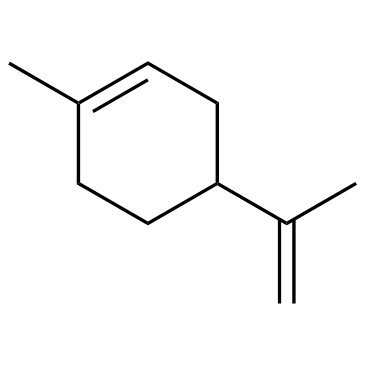536-59-4
| Name | perillyl alcohol |
|---|---|
| Synonyms |
tri-otolylboroxine
UNII:319R5C7293 Perilla alcohol [4-(Prop-1-en-2-yl)cyclohex-1-en-1-yl]methanol (-)-PERILLYL ALCOHOL perill alcohol (4-(prop-1-en-2-yl)cyclohex-1-enyl)methanol (S)-p-Mentha-1,8-dien-7-ol,(S)-4-Isopropenyl-1-cyclohexenylmethanol MFCD00062995 [4-(1-Methylethenyl)-1-cyclohexen-1-yl]methanol 1,8-p-Menthadien-7-ol p-Mentha-1,8-dien-7-ol Perillol (4-(prop-1-en-2-yl)cyclohex-1-enyl)carbinol p-Mentha-1,8-diene-7-ol DIHYDRO CUMINYL ALCOHOL (4-isopropenyl-cyclohex-1-enyl)-methanol Perillic alcohol (4-(Prop-1-en-2-yl)cyclohex-1-en-1-yl)methanol L-(-)-Perilly Alcohol 1-perillalcohol 1-Cyclohexene-1-methanol, 4-(1-methylethenyl) L6UTJ A1Q DY1&U1 Perillyl alcohol (4-Isopropenyl-1-cyclohexen-1-yl)methanol 1-Cyclohexene-1-methanol, 4-(1-methylethenyl)- perilla |
| Description | Perillyl alcohol is a monoterpene isolated from the essential oils of lavendin, peppermint, spearmint, cherries, celery seeds, and several other plants. Perillyl alcohol is active in inducing apoptosis in tumor cells without affecting normal cells[1]. |
|---|---|
| Related Catalog | |
| References |
[1]. Belanger JT. Perillyl alcohol: applications in oncology. Altern Med Rev. 1998 Dec;3(6):448-57. |
| Density | 0.9±0.1 g/cm3 |
|---|---|
| Boiling Point | 241.2±19.0 °C at 760 mmHg |
| Molecular Formula | C10H16O |
| Molecular Weight | 152.233 |
| Flash Point | 99.6±17.8 °C |
| Exact Mass | 152.120117 |
| PSA | 20.23000 |
| LogP | 3.30 |
| Vapour Pressure | 0.0±1.1 mmHg at 25°C |
| Index of Refraction | 1.491 |
Synonym:Dihydrocuminyl Alcohol; 4-Isopropenyl-Cyclohex-1-Ene-1-Methanol; Perilla Alcohol Section 2 - COMPOSITION, INFORMATION ON INGREDIENTS
Risk Phrases: 36/38 Section 3 - HAZARDS IDENTIFICATION EMERGENCY OVERVIEW
Irritating to eyes and skin. Potential Health Effects Eye: Causes eye irritation. May cause chemical conjunctivitis. Skin: Causes skin irritation. Ingestion: May cause gastrointestinal irritation with nausea, vomiting and diarrhea. Inhalation: May cause respiratory tract irritation. Can produce delayed pulmonary edema. Chronic: Effects may be delayed. Section 4 - FIRST AID MEASURES Eyes: Immediately flush eyes with plenty of water for at least 15 minutes, occasionally lifting the upper and lower eyelids. Get medical aid immediately. Skin: Get medical aid immediately. Immediately flush skin with plenty of water for at least 15 minutes while removing contaminated clothing and shoes. Wash clothing before reuse. Ingestion: Never give anything by mouth to an unconscious person. Get medical aid. Do NOT induce vomiting. If conscious and alert, rinse mouth and drink 2-4 cupfuls of milk or water. Inhalation: Remove from exposure and move to fresh air immediately. If not breathing, give artificial respiration. If breathing is difficult, give oxygen. Get medical aid. Notes to Physician: Treat symptomatically and supportively. Section 5 - FIRE FIGHTING MEASURES General Information: As in any fire, wear a self-contained breathing apparatus in pressure-demand, MSHA/NIOSH (approved or equivalent), and full protective gear. During a fire, irritating and highly toxic gases may be generated by thermal decomposition or combustion. Vapors may be heavier than air. They can spread along the ground and collect in low or confined areas. Runoff from fire control or dilution water may cause pollution. Extinguishing Media: Use agent most appropriate to extinguish fire. Use water spray, dry chemical, carbon dioxide, or appropriate foam. Section 6 - ACCIDENTAL RELEASE MEASURES General Information: Use proper personal protective equipment as indicated in Section 8. Spills/Leaks: Absorb spill with inert material (e.g. vermiculite, sand or earth), then place in suitable container. Avoid runoff into storm sewers and ditches which lead to waterways. Clean up spills immediately, observing precautions in the Protective Equipment section. Provide ventilation. Section 7 - HANDLING and STORAGE Handling: Wash thoroughly after handling. Remove contaminated clothing and wash before reuse. Avoid contact with eyes, skin, and clothing. Keep container tightly closed. Avoid ingestion and inhalation. Use with adequate ventilation. Storage: Store in a tightly closed container. Store in a cool, dry, well-ventilated area away from incompatible substances. Section 8 - EXPOSURE CONTROLS, PERSONAL PROTECTION Engineering Controls: Facilities storing or utilizing this material should be equipped with an eyewash facility and a safety shower. Use process enclosure, local exhaust ventilation, or other engineering controls to control airborne levels. Exposure Limits CAS# 536-59-4: Personal Protective Equipment Eyes: Wear appropriate protective eyeglasses or chemical safety goggles as described by OSHA's eye and face protection regulations in 29 CFR 1910.133 or European Standard EN166. Skin: Wear appropriate protective gloves to prevent skin exposure. Clothing: Wear appropriate protective clothing to minimize contact with skin. Respirators: A respiratory protection program that meets OSHA's 29 CFR 1910.134 and ANSI Z88.2 requirements or European Standard EN 149 must be followed whenever workplace conditions warrant respirator use. Section 9 - PHYSICAL AND CHEMICAL PROPERTIES Physical State: Liquid Color: clear, colorless Odor: Not available. pH: Not available. Vapor Pressure: Not available. Viscosity: Not available. Boiling Point: 119 - 121 deg C @ 11.00mmHg Freezing/Melting Point: Not available. Autoignition Temperature: Not available. Flash Point: Not available. Explosion Limits, lower: Not available. Explosion Limits, upper: Not available. Decomposition Temperature: Solubility in water: Specific Gravity/Density: .9600g/cm3 Molecular Formula: C10H16O Molecular Weight: 152.24 Section 10 - STABILITY AND REACTIVITY Chemical Stability: Stable at room temperature in closed containers under normal storage and handling conditions. Conditions to Avoid: Incompatible materials, excess heat, strong oxidants. Incompatibilities with Other Materials: Oxidizing agents. Hazardous Decomposition Products: Carbon monoxide, irritating and toxic fumes and gases, carbon dioxide. Hazardous Polymerization: Has not been reported Section 11 - TOXICOLOGICAL INFORMATION RTECS#: CAS# 536-59-4: OS8395000 LD50/LC50: CAS# 536-59-4: Draize test, rabbit, skin: 500 mg/24H Severe; Oral, rat: LD50 = 2100 mg/kg; Skin, rabbit: LD50 = >5 gm/kg. Carcinogenicity: L(-)-Perillyl Alcohol - Not listed by ACGIH, IARC, or NTP. Other: See actual entry in RTECS for complete information. Section 12 - ECOLOGICAL INFORMATION Section 13 - DISPOSAL CONSIDERATIONS Dispose of in a manner consistent with federal, state, and local regulations. Section 14 - TRANSPORT INFORMATION IATA Shipping Name: Not regulated. Hazard Class: UN Number: Packing Group: IMO Shipping Name: Not regulated. Hazard Class: UN Number: Packing Group: RID/ADR Shipping Name: Not regulated. Hazard Class: UN Number: Packing group: Section 15 - REGULATORY INFORMATION European/International Regulations European Labeling in Accordance with EC Directives Hazard Symbols: XI Risk Phrases: R 36/38 Irritating to eyes and skin. Safety Phrases: S 24/25 Avoid contact with skin and eyes. WGK (Water Danger/Protection) CAS# 536-59-4: No information available. Canada CAS# 536-59-4 is listed on Canada's DSL List. CAS# 536-59-4 is listed on Canada's Ingredient Disclosure List. US FEDERAL TSCA CAS# 536-59-4 is listed on the TSCA inventory. SECTION 16 - ADDITIONAL INFORMATION N/A |
CHEMICAL IDENTIFICATION
HEALTH HAZARD DATAACUTE TOXICITY DATA
|
| Hazard Codes | Xi: Irritant; |
|---|---|
| Risk Phrases | 37/38-41 |
| Safety Phrases | S26;S39 |
| WGK Germany | 3 |
| RTECS | OS8395000 |
| HS Code | 2906199090 |
| Precursor 4 | |
|---|---|
| DownStream 8 | |
| HS Code | 2906199090 |
|---|---|
| Summary | 2906199090. cyclanic, cyclenic or cyclotherpenic alcohols. VAT:17.0%. Tax rebate rate:13.0%. . MFN tariff:5.5%. General tariff:30.0% |


